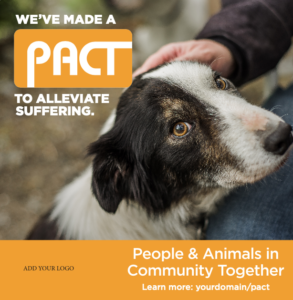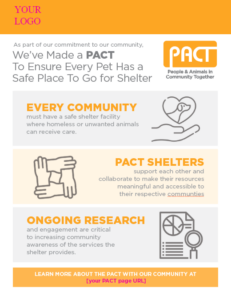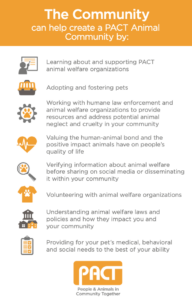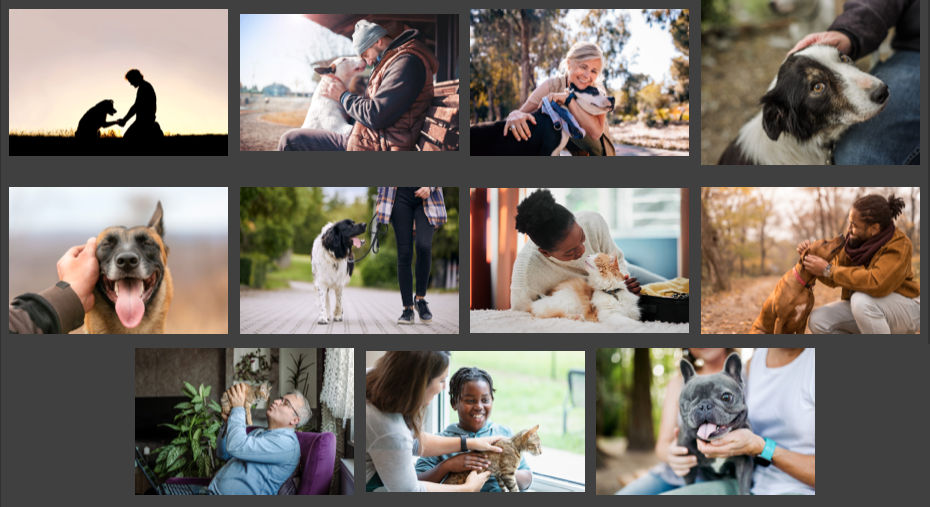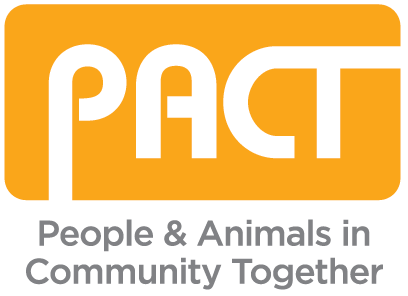
Each of us has a role in supporting the welfare and well-being of animals in our community. Whether you’re a humane educator teaching children to respect the living world or a community volunteer at a local animal shelter or rescue, you are helping to create the best outcomes for animals – both near and far.
Driven by compassion, transparency, and leadership, People and Animals in Community Together (PACT) recognizes the power of working together. Companion animals thrive when people from all walks of life lend their knowledge and experience to supporting animal welfare, nurturing the human-animal bond and fostering safe, inclusive, and humane communities.
We invite your organization to use the resources found in the communications toolkit below to promote your organization's commitment to the PACT tenets. Please feel free to customize PACT graphics with your own branding and graphic standards in order to connect your organization with PACT.
PACT is a compassionate, transparent and thoughtful model of how shelters, rescues, and other animal welfare organizations can best support vulnerable animals. PACT is a shared set of tenents that animal welfare organizations around the world are embracing to create best possible outcomes for companion animals.
There are nine tenets of PACT and animal shelters across the country have committed to this way of caring for animals and, as a result, animals in these shelters and rescues are having the best possible outcomes. Every community has a responsibility to its animals and should demand that animals receive the care and respect they deserve. What follows is a summary of these tenets:
PACT TENETS
PACT shelters and rescues find placements for all pets who:
- Either have no signs of clinical disease or have evidence of disease that has a good or excellent prognosis for a comfortable life, AND
- Have not exhibited behavior that is likely to result in severe injury or death to another animal or person.
Notably, this tenet does not preclude PACT shelters from placing pets who have medical or behavioral conditions that can be safely and effectively managed outside of the shelter environment.
PACT shelters are committed to preventing and easing suffering for each animal in their care. To that end, animals housed in shelters or rescues must receive regular health assessments and proper veterinary care to treat any injury or disease. Shelters must also assess each animal’s individual behavioral needs and provide thoughtful enrichment to keep them comfortable and prevent or redirect any destructive, obsessive-compulsive, or similar coping behaviors.
PACT RESOURCES
Infographics (PDF)
The infographics below represent the seven different communities who contribute to People and Animals in Community Together (PACT). Each infographic shows the different ways that each group can contribute to making a PACT.
- Shelters
- Policy Makers
- Rescue Groups
- Veterinarians
- Law Enforcement
- Human-animal Resource Providers
- The Community
TENET IMPLEMENTATION RESOURCES
These are resources to assist with the implementation of each tenet of PACT.
Ensure every unwanted or homeless pet has a safe place to go for shelter and care.
- The Association for Animal Welfare Advancement Adoption Model Practice (PDF)
- The Association for Animal Welfare Advancement Model Practices (click on Model Practices button)
- Shelter Animals Count
- PACFA guidelines (PDF)
Place (at least) every healthy and safe animal.
- The Association for Animal Welfare Advancement Provision of Veterinary Care in a Shelter Setting Model Practices (PDF)
- Association of Shelter Veterinarian Guidelines
- Association of Shelter Veterinarian Guidelines Checklist (PDF)
Assess the medical and behavioral needs of homeless animals, and ensure these needs are thoughtfully addressed.
- Fear Free Shelter Program
- Shelter Playgroup Alliance Guidelines (PDF)
- The Association for Animal Welfare Advancement Animal Enrichment Model Practice (PDF)
Alleviate suffering and make appropriate euthanasia decisions.
- Humane Side of Euthanasia (Article)
Consider the health and wellness of each animal and community when transferring animals between communities.
- The Association for Animal Welfare Advancement Companion Animal Transport Model Practices (PDF)
- Humane Dog Training Advocates Responsible Rescue Handout (PDF)
Implement inclusive policies and practices.
- Companions and Animals for Reform and Equity [CARE]
- How to get better at using inclusive language in the workplace
- Why diversifying animal welfare helps shelters and pets – and ways to do it
- Global Diversity, Equity & Inclusion Benchmarks: Standards for Organizations Around the World
Foster a culture of transparency, ethical decision making, mutual respect, continual learning, and collaboration.


